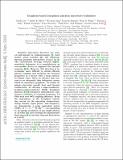Graphene-based Josephson junction microwave bolometer
Author(s)
Walsh, Evan Daniel; Englund, Dirk R.
DownloadAccepted version (727.1Kb)
Publisher Policy
Publisher Policy
Article is made available in accordance with the publisher's policy and may be subject to US copyright law. Please refer to the publisher's site for terms of use.
Terms of use
Metadata
Show full item recordAbstract
Sensitive microwave detectors are essential in radioastronomy1, dark-matter axion searches2 and superconducting quantum information science3,4. The conventional strategy to obtain higher-sensitivity bolometry is the nanofabrication of ever smaller devices to augment the thermal response5–7. However, it is difficult to obtain efficient photon coupling and to maintain the material properties in a device with a large surface-to-volume ratio owing to surface contamination. Here we present an ultimately thin bolometric sensor based on monolayer graphene. To utilize the minute electronic specific heat and thermal conductivity of graphene, we develop a superconductor–graphene–superconductor Josephson junction8–13 bolometer embedded in a microwave resonator with a resonance frequency of 7.9 gigahertz and over 99 per cent coupling efficiency. The dependence of the Josephson switching current on the operating temperature, charge density, input power and frequency shows a noise-equivalent power of 7 × 10−19 watts per square-root hertz, which corresponds to an energy resolution of a single 32-gigahertz photon14, reaching the fundamental limit imposed by intrinsic thermal fluctuations at 0.19 kelvin. Our results establish that two-dimensional materials could enable the development of bolometers with the highest sensitivity allowed by the laws of thermodynamics.
Date issued
2020-09Department
Massachusetts Institute of Technology. Department of Electrical Engineering and Computer ScienceJournal
Nature
Publisher
Springer Science and Business Media LLC
Citation
Lee, Gil-Ho et al. “Graphene-based Josephson junction microwave bolometer.” Nature, 586, 7828 (September 2020): 42–46 © 2020 The Author(s)
Version: Author's final manuscript
ISSN
0028-0836